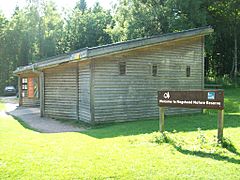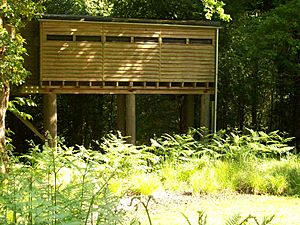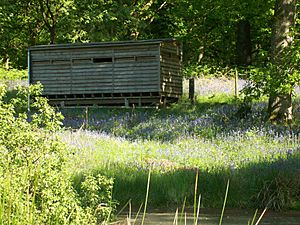Nagshead facts for kids
Quick facts for kids RSPB Nagshead |
|
|---|---|

Visitor centre
|
|
| Lua error in Module:Location_map at line 420: attempt to index field 'wikibase' (a nil value). | |
| Type | RSPB Reserve |
| Location | Parkend, Forest of Dean, Gloucestershire, UK |
| Area | 1,250 acres (510 ha) |
| Operated by | RSPB and Forestry Commission |
| Status | Open all year |
Nagshead is a wonderful woodland nature reserve. You can find it on the edge of Parkend in the Forest of Dean, Gloucestershire, UK. It is managed by the RSPB, which stands for the Royal Society for the Protection of Birds.
More than half of this reserve is made up of oak trees planted way back in the 1800s. Today, this forest is carefully looked after. The goal is to protect its natural beauty and help all the plants and animals that live there.
In 1942, people put up special nest boxes at Nagshead. They hoped that pied flycatchers would move in. These birds eat oak leafroller moth caterpillars, which were harming the trees. Since 1948, these nest boxes have been watched every year. This makes it the longest-running bird breeding program in the UK! Nagshead also includes a special area called a biological Site of Special Scientific Interest (SSSI). This means it's a very important place for nature.
What Can You Do Here?
Nagshead reserve is open all year round. It's free to enter, and parking your car is also free.
Here are some things you can find at Nagshead:
- A visitor centre and toilets, open on weekends during summer.
- A large car park for visitors.
- Two special viewing hides where you can watch birds.
- Two marked walking trails, one is about 1 mile and the other is 2.25 miles long.
- A picnic area where you can enjoy your snacks.
- Information boards to help you learn more about the reserve.
Amazing Birds of Nagshead
Nagshead is a fantastic place for birdwatching! You can often see wrens, buzzards, redstarts, pied flycatchers, and crossbills.
If you are lucky, you might also spot other cool birds. These include great spotted woodpeckers, nuthatches, redwings, woodcocks, and wood warblers.
Other Cool Wildlife
Nagshead is home to much more than just birds. Over 30 different kinds of butterflies have been seen here. You can also find more than 20 types of dragonflies and damselflies.
Eight of Britain's twelve types of reptiles and amphibians live and breed at Nagshead. These include the common lizard, slowworm, adder, grass snake, common frog, common toad, smooth newt, and palmate newt.
Wild boar also live in Nagshead, but they are very shy and rarely seen by visitors.
What is Nagshead SSSI?
A small but very important part of the Nagshead reserve is called a biological Site of Special Scientific Interest (SSSI). This special area covers about 120 hectares (around 300 acres). It is next to the Nagshead Plantation. The B4234 road runs right through the middle of it. This SSSI is located around Nagshead Hill, Cleave Hill, and Fetter Hill.



